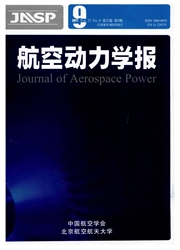

 中文摘要:
中文摘要:
The non-linear behavior of continuous fiber reinforced C/SiC ceramic matrix composites(CMCs)under tensile loading is modeled by three-dimensional representative volume element(RVE)models of the composite. The theoretical background of the multi-scale approach solved by the finite element method(FEM)is recalled firstly.Then the geometric characters of three kinds of damage mechanisms,i.e.micro matrix cracks,fiber/matrix interface debonding and fiber fracture,are studied.Three kinds of RVE are proposed to model the microstructure of C/SiC with above damage mechanisms respectively.The matrix cracking is modeled by critical matrix strain energy(CMSE)principle while a maximum shear stress criterion is used for modeling fiber/matrix interface debonding. The behavior of fiber fracture is modeled by the famous Weibull statistic theory.A numerical example of continuous fiber reinforced C/SiC composite under tensile loading is performed.The results show that the stress/strain curve predicted by the developed model agrees with experimental data.
 英文摘要:
英文摘要:
The non-linear behavior of continuous fiber reinforced C/SiC ceramic matrix composites (CMCs) under tensile loading is modeled by three-dimensional representative volume element (RVE) models of the composite. The theoretical background of the multi-scale approach solved by the finite element method (FEM) is recalled first- ly. Then the geometric characters of three kinds of damage mechanisms, i.e. micro matrix cracks, fiber/matrix interface debonding and fiber fracture, are studied. Three kinds of RVE are proposed to model the microstructure of C/SiC with above damage mechanisms respectively. The matrix cracking is modeled by critical matrix strain en- ergy (CMSE) principle while a maximum shear stress criterion is used for modeling fiber/matrix interface debond- ing. The behavior of fiber fracture is modeled by the famous Weibull statistic theory. A numerical example of con- tinuous fiber reinforced C/SiC composite under tensile loading is performed. The results show that the stress/ strain curve predicted by the developed model agrees with experimental data.
 同期刊论文项目
同期刊论文项目
 同项目期刊论文
同项目期刊论文
 Hysteresis loop model of unidirectional carbon fiber-reinforced ceramic matrix composites under an a
Hysteresis loop model of unidirectional carbon fiber-reinforced ceramic matrix composites under an a A temperature-dependent constitutive model for fiber-reinforced ceramic matrix composites and struct
A temperature-dependent constitutive model for fiber-reinforced ceramic matrix composites and struct 期刊信息
期刊信息
